key TOYOTA YARIS 2014 Owners Manual
[x] Cancel search | Manufacturer: TOYOTA, Model Year: 2014, Model line: YARIS, Model: TOYOTA YARIS 2014Pages: 712, PDF Size: 30.2 MB
Page 432 of 712
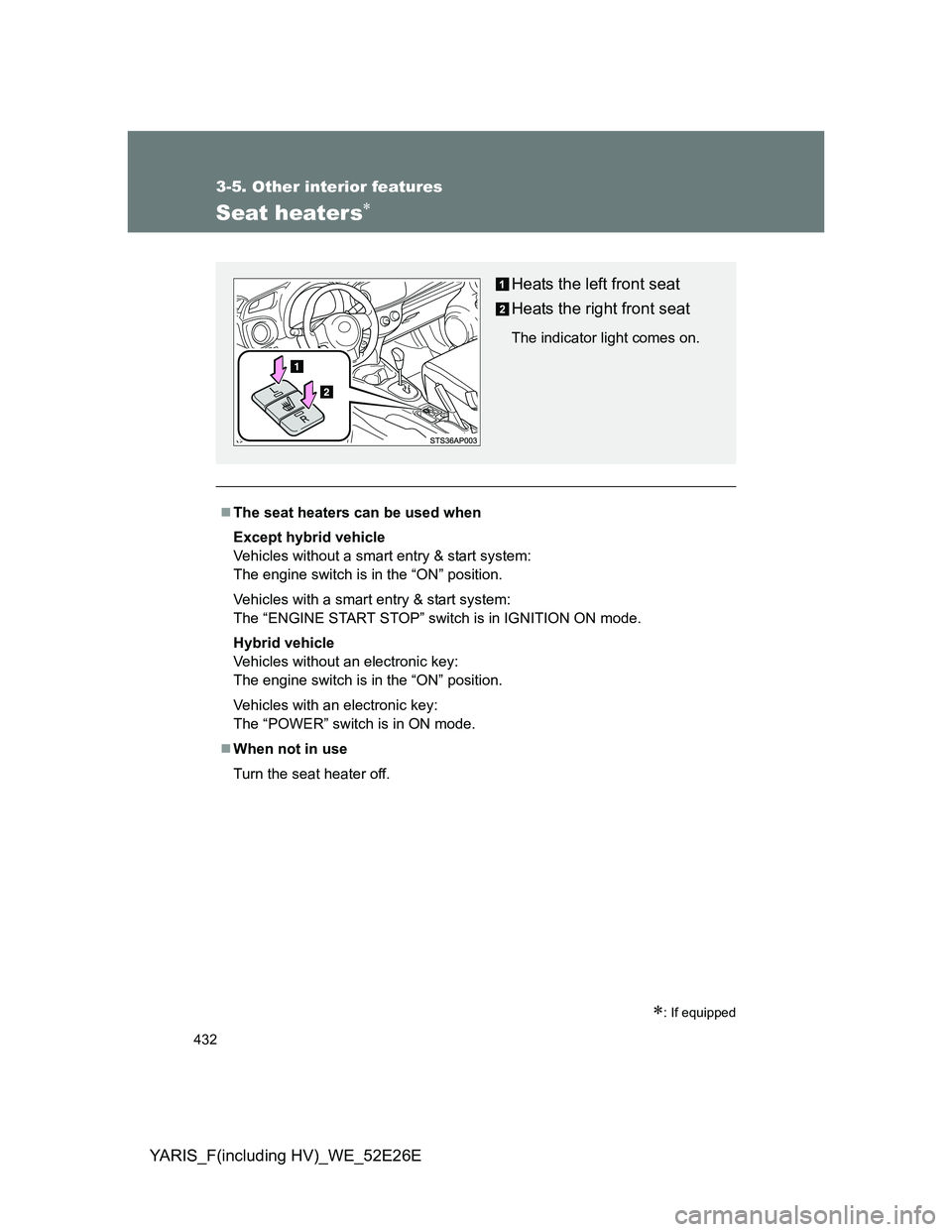
432
3-5. Other interior features
YARIS_F(including HV)_WE_52E26E
Seat heaters
: If equipped
The seat heaters can be used when
Except hybrid vehicle
Vehicles without a smart entry & start system:
The engine switch is in the “ON” position.
Vehicles with a smart entry & start system:
The “ENGINE START STOP” switch is in IGNITION ON mode.
Hybrid vehicle
Vehicles without an electronic key:
The engine switch is in the “ON” position.
Vehicles with an electronic key:
The “POWER” switch is in ON mode.
When not in use
Turn the seat heater off.
Heats the left front seat
Heats the right front seat
The indicator light comes on.
Page 443 of 712
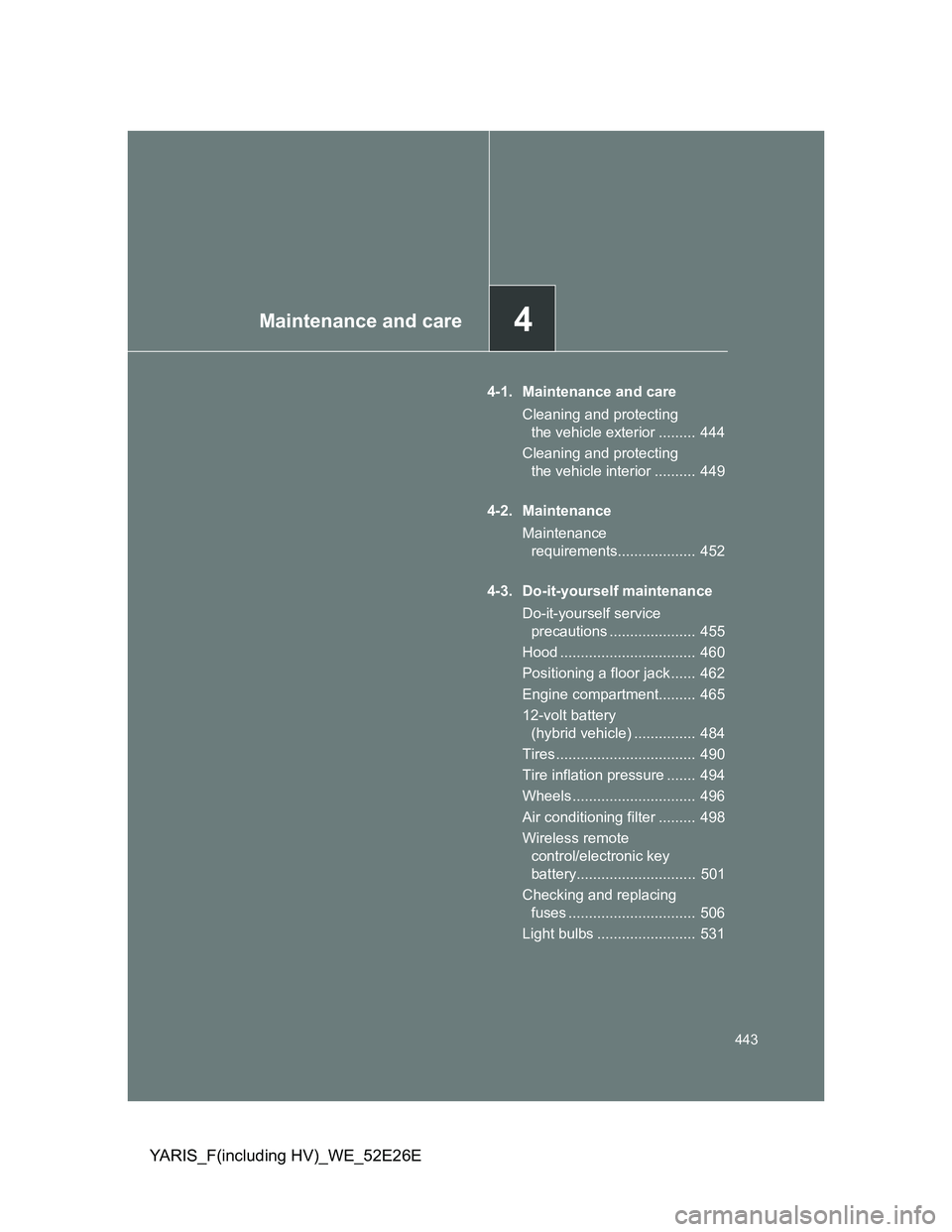
4Maintenance and care
443
YARIS_F(including HV)_WE_52E26E
4-1. Maintenance and care
Cleaning and protecting
the vehicle exterior ......... 444
Cleaning and protecting
the vehicle interior .......... 449
4-2. Maintenance
Maintenance
requirements................... 452
4-3. Do-it-yourself maintenance
Do-it-yourself service
precautions ..................... 455
Hood ................................. 460
Positioning a floor jack ...... 462
Engine compartment......... 465
12-volt battery
(hybrid vehicle) ............... 484
Tires .................................. 490
Tire inflation pressure ....... 494
Wheels .............................. 496
Air conditioning filter ......... 498
Wireless remote
control/electronic key
battery............................. 501
Checking and replacing
fuses ............................... 506
Light bulbs ........................ 531
Page 445 of 712
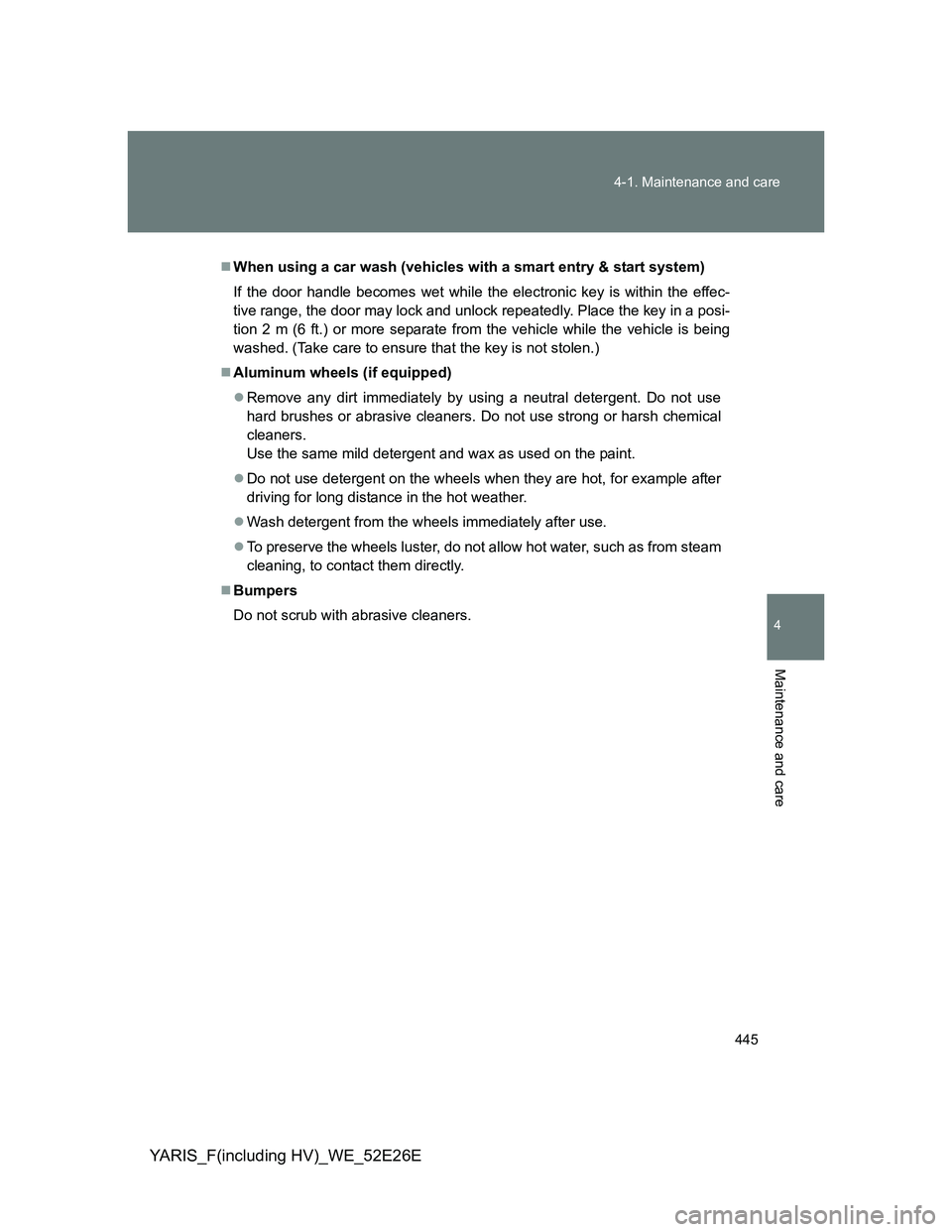
445 4-1. Maintenance and care
4
Maintenance and care
YARIS_F(including HV)_WE_52E26E
When using a car wash (vehicles with a smart entry & start system)
If the door handle becomes wet while the electronic key is within the effec-
tive range, the door may lock and unlock repeatedly. Place the key in a posi-
tion 2 m (6 ft.) or more separate from the vehicle while the vehicle is being
washed. (Take care to ensure that the key is not stolen.)
Aluminum wheels (if equipped)
Remove any dirt immediately by using a neutral detergent. Do not use
hard brushes or abrasive cleaners. Do not use strong or harsh chemical
cleaners.
Use the same mild detergent and wax as used on the paint.
Do not use detergent on the wheels when they are hot, for example after
driving for long distance in the hot weather.
Wash detergent from the wheels immediately after use.
To preserve the wheels luster, do not allow hot water, such as from steam
cleaning, to contact them directly.
Bumpers
Do not scrub with abrasive cleaners.
Page 457 of 712

457 4-3. Do-it-yourself maintenance
4
Maintenance and care
YARIS_F(including HV)_WE_52E26E
CAUTION
The engine compartment contains many mechanisms and fluids that may
move suddenly, become hot, or become electrically energized. To avoid death
or serious injury, observe the following precautions:
When working on the engine compartment:
On hybrid vehicles, make sure that the engine switch is in the “LOCK”
position (vehicles without an electronic key) or the “POWER” switch off
(vehicles with an electronic key) and the “READY” indicator are both off.
Keep hands, clothing and tools away from the moving fan and engine
drive belt.
Be careful not to touch the engine, power control unit (hybrid vehicle), radi-
ator, exhaust manifold, etc. right after driving as they may be hot. Oil and
other fluids may also be hot.
Do not leave anything that may burn easily, such as paper and rags, in the
engine compartment.
Do not smoke, cause sparks or expose an open flame to fuel or the bat-
tery. Fuel and battery fumes are flammable.
Be extremely cautious when working on the battery. It contains poisonous
and corrosive sulfuric acid.
Take care because brake fluid can harm your hands or eyes and damage
painted surfaces. If fluid gets on your hands or in your eyes, flush the
affected area with clean water immediately.
If you still experience discomfort, consult a doctor.
Page 458 of 712

458 4-3. Do-it-yourself maintenance
YARIS_F(including HV)_WE_52E26E
CAUTION
When working near the electric cooling fan or radiator grille
Except hybrid vehicle
Vehicles without a smart entry & start system:
Be sure the engine switch is in the “LOCK” position.
With the engine switch in the “ON” position, the electric cooling fan may
automatically start to run if the air conditioning is on and/or the coolant tem-
perature is high. (P. 478)
Vehicles with a smart entry & start system:
Be sure the “ENGINE START STOP” switch is off.
With the “ENGINE START STOP” switch in IGNITION ON mode, the electric
cooling fan may automatically start to run if the air conditioning is on and/or
the coolant temperature is high. (P. 478)
Hybrid vehicle
Vehicles without an electronic key:
Be sure the engine switch is in the “LOCK” position.
With the engine switch in the “ON” position, the electric cooling fan may
automatically start to run if the air conditioning is on and/or the coolant tem-
perature is high. (P. 478)
Vehicles with an electronic key:
Be sure the “POWER” switch is off.
With the “POWER” switch in ON mode, the electric cooling fan may automat-
ically start to run if the air conditioning is on and/or the coolant temperature
is high. (P. 478)
Safety glasses
Wear safety glasses to prevent flying or falling material, fluid spray, etc. from
getting in your eyes.
Page 480 of 712
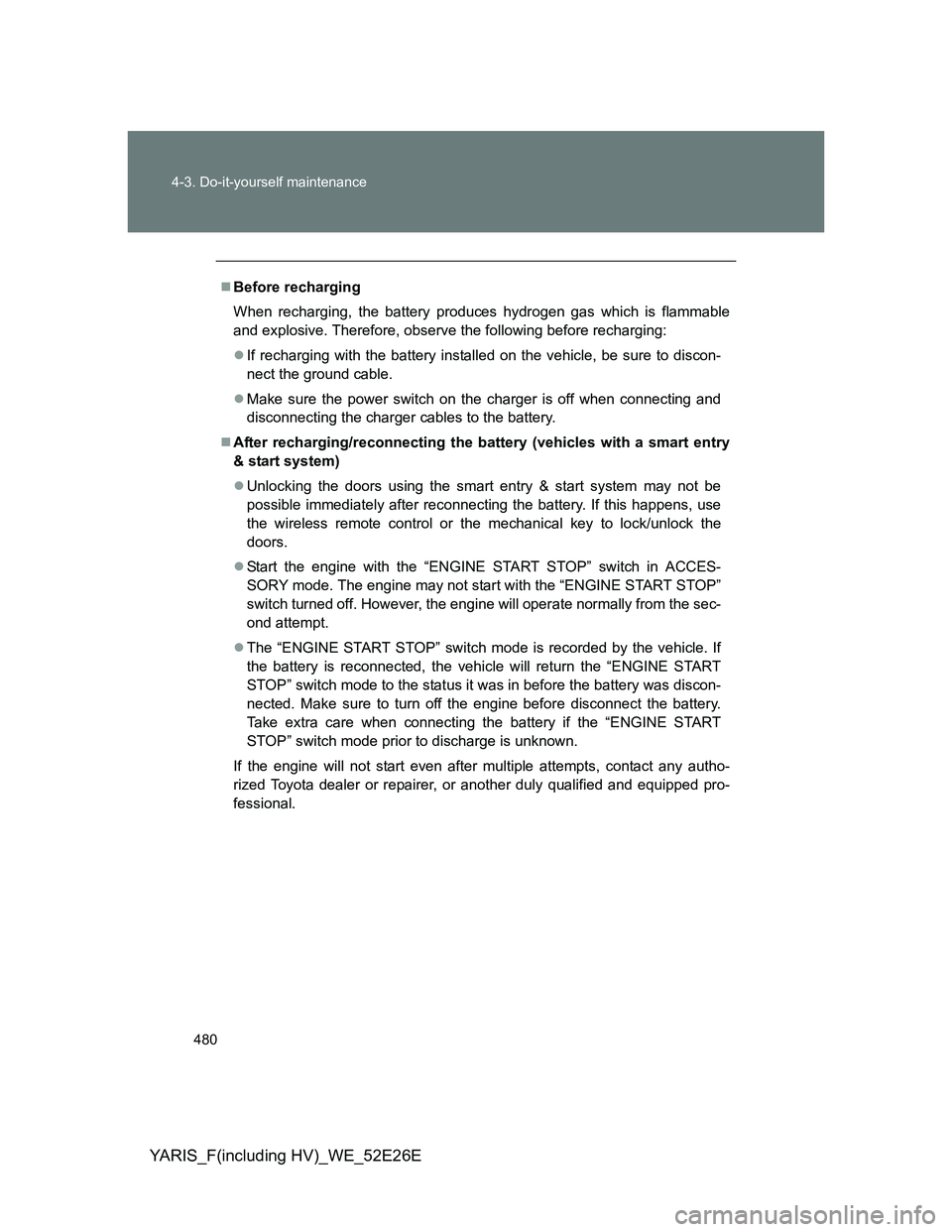
480 4-3. Do-it-yourself maintenance
YARIS_F(including HV)_WE_52E26E
Before recharging
When recharging, the battery produces hydrogen gas which is flammable
and explosive. Therefore, observe the following before recharging:
If recharging with the battery installed on the vehicle, be sure to discon-
nect the ground cable.
Make sure the power switch on the charger is off when connecting and
disconnecting the charger cables to the battery.
After recharging/reconnecting the battery (vehicles with a smart entry
& start system)
Unlocking the doors using the smart entry & start system may not be
possible immediately after reconnecting the battery. If this happens, use
the wireless remote control or the mechanical key to lock/unlock the
doors.
Start the engine with the “ENGINE START STOP” switch in ACCES-
SORY mode. The engine may not start with the “ENGINE START STOP”
switch turned off. However, the engine will operate normally from the sec-
ond attempt.
The “ENGINE START STOP” switch mode is recorded by the vehicle. If
the battery is reconnected, the vehicle will return the “ENGINE START
STOP” switch mode to the status it was in before the battery was discon-
nected. Make sure to turn off the engine before disconnect the battery.
Take extra care when connecting the battery if the “ENGINE START
STOP” switch mode prior to discharge is unknown.
If the engine will not start even after multiple attempts, contact any autho-
rized Toyota dealer or repairer, or another duly qualified and equipped pro-
fessional.
Page 487 of 712

487 4-3. Do-it-yourself maintenance
4
Maintenance and care
YARIS_F(including HV)_WE_52E26E
Before recharging
When recharging, the 12-volt battery produces hydrogen gas which is flam-
mable and explosive. Therefore, observe the following precautions before
recharging:
If recharging with the 12-volt battery installed on the vehicle, be sure to
disconnect the ground cable.
Make sure the power switch on the charger is off when connecting and
disconnecting the charger cables to the 12-volt battery.
When disconnecting the 12-volt battery terminals
Always disconnect the negative (-) terminal first.
After recharging/reconnecting the 12-volt battery
Unlocking the doors using the smart entry & start system may not be
possible immediately after reconnecting the 12-volt battery. If this hap-
pens, use the wireless remote control or the mechanical key to lock/
unlock the doors.
Vehicles with an electronic key: Start the hybrid system with the
“POWER” switch in ACCESSORY mode. The hybrid system may not
start with the “POWER” switch turned off. However, the hybrid system will
operate normally from the second attempt.
Vehicles with an electronic key: The “POWER” switch mode is recorded
by the vehicle. If the 12-volt battery is reconnected, the vehicle will return
the “POWER” switch mode to the status it was in before the 12-volt bat-
tery was disconnected. Make sure to turn off the power before discon-
nect the 12-volt battery. Take extra care when connecting the 12-volt
battery if the “POWER” switch mode prior to discharge is unknown.
If the system will not start even after multiple attempts, contact any autho-
rized Toyota dealer or repairer, or another duly qualified and equipped pro-
fessional.
Page 498 of 712
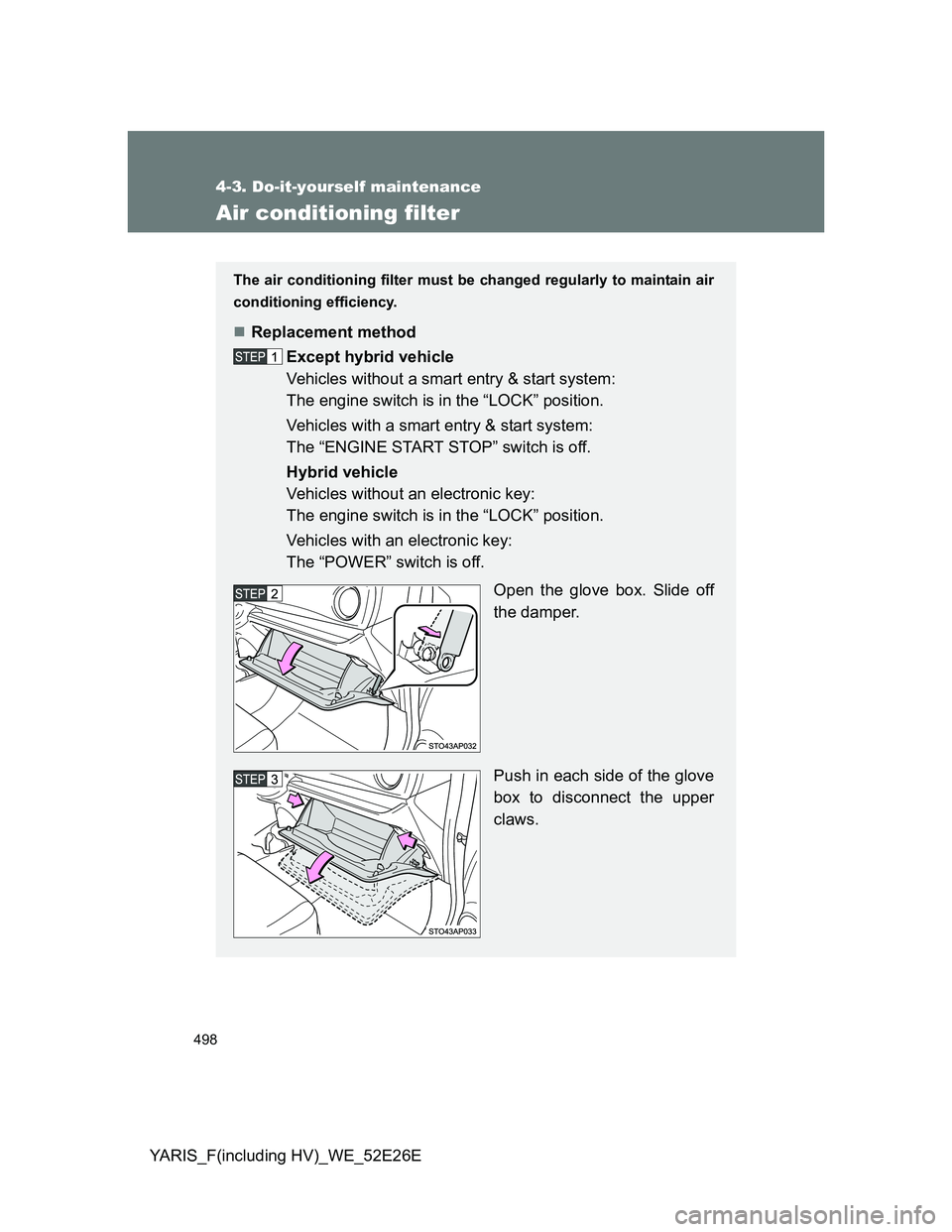
498
4-3. Do-it-yourself maintenance
YARIS_F(including HV)_WE_52E26E
Air conditioning filter
The air conditioning filter must be changed regularly to maintain air
conditioning efficiency.
Replacement method
Except hybrid vehicle
Vehicles without a smart entry & start system:
The engine switch is in the “LOCK” position.
Vehicles with a smart entry & start system:
The “ENGINE START STOP” switch is off.
Hybrid vehicle
Vehicles without an electronic key:
The engine switch is in the “LOCK” position.
Vehicles with an electronic key:
The “POWER” switch is off.
Open the glove box. Slide off
the damper.
Push in each side of the glove
box to disconnect the upper
claws.
Page 501 of 712
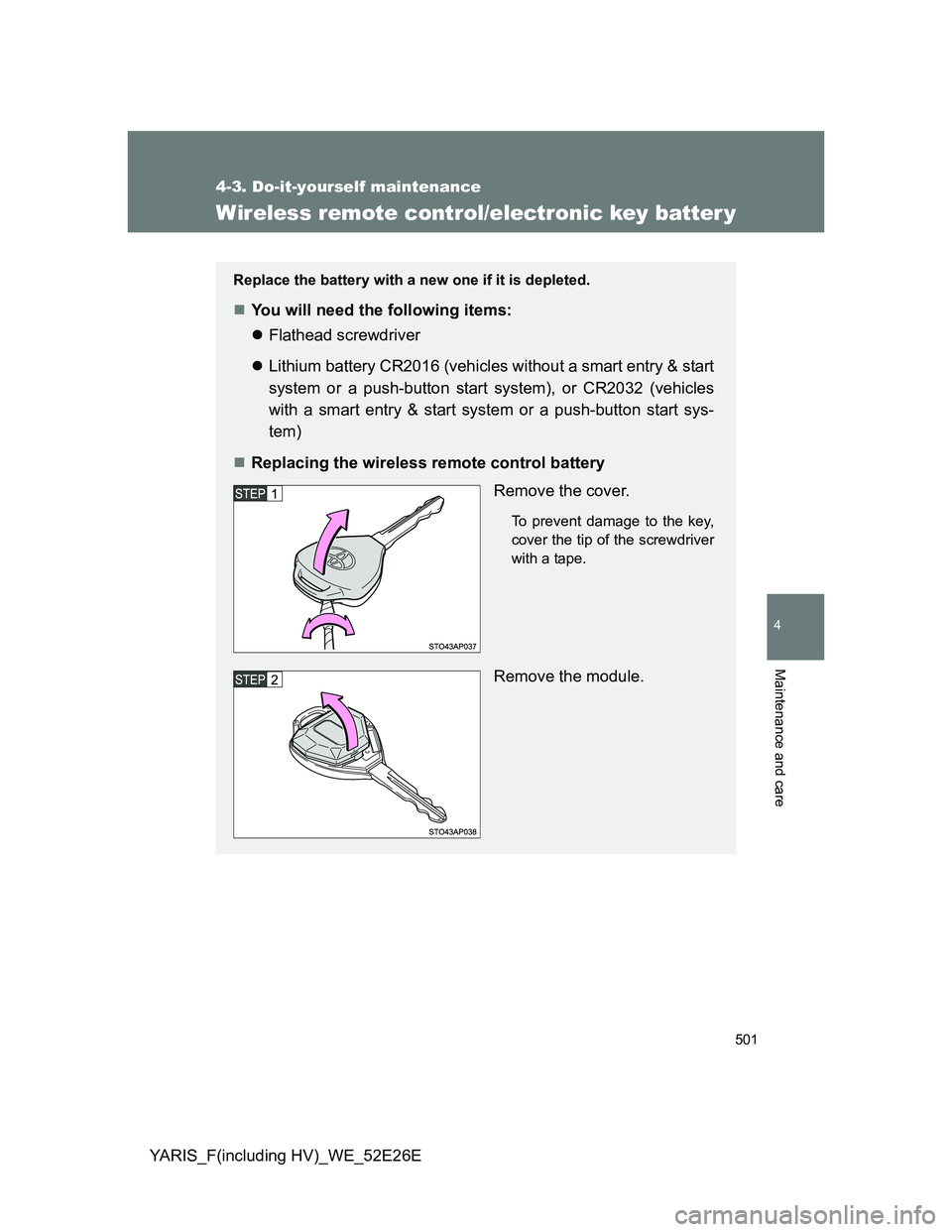
501
4-3. Do-it-yourself maintenance
4
Maintenance and care
YARIS_F(including HV)_WE_52E26E
Wireless remote control/electronic key batter y
Replace the battery with a new one if it is depleted.
You will need the following items:
Flathead screwdriver
Lithium battery CR2016 (vehicles without a smart entry & start
system or a push-button start system), or CR2032 (vehicles
with a smart entry & start system or a push-button start sys-
tem)
Replacing the wireless remote control battery
Remove the cover.
To prevent damage to the key,
cover the tip of the screwdriver
with a tape.
Remove the module.
Page 502 of 712

502 4-3. Do-it-yourself maintenance
YARIS_F(including HV)_WE_52E26E
Remove the battery cover and
the depleted battery.
Insert a new battery with the
“+” terminal facing up.
Replacing the electronic key battery
Ty p e A
Take out the mechanical key.
Remove the cover.
To prevent damage to the key,
cover the tip of the screwdriver
with a tape.